List of heads of state of Mexico
The Head of State in Mexico is the person who controls the executive power in the country. Under the current constitution, this responsibility lies in the President of the United Mexican States, who is head of the supreme executive power of the Mexican Union.[1] Throughout its history, Mexico has had several forms of government. Under the federal constitutions, the title of President was the same as the current. Under the Seven Laws (centralist), was named President of the Republic. In addition, there have been two periods of monarchical rule, during which the executive was controlled by the Emperor of Mexico.
The chronology of the heads of state of Mexico is complicated due the country's political instability during most of the nineteenth century and early decades of the twentieth century. With few exceptions, most of the Mexican presidents elected during this period did not complete their terms. Until the presidency of Lázaro Cárdenas, each president had remained in office an average of fifteen months.[2]
This list also included the self-appointed presidents during civil wars and the collegiate bodies that performed the Mexican Executive duties during periods of transition.
 |
|---|
|
|
Mexican Empire (1821–1823)
First Regency
After the consummation of the Independence of Mexico, it was settled a Provisional Board of Governing formed by thirty-four persons. The Board decreed and signed the Declaration of Independence of the Mexican Empire and appointed a regency composed by six people.
| Regent[3] | Took office | Left office | Notes | |
|---|---|---|---|---|

|
Agustín de Iturbide | September 28, 1821 | April 11, 1822 | |

|
Juan O'Donojú | September 28, 1821 | October 8, 1821 | He died on October 8. |

|
Antonio Pérez Martínez | October 8, 1821 | April 11, 1822 | |

|
Manuel de la Barcéna | September 28, 1821 | April 11, 1822 | |

|
José Isidro Yañez | September 28, 1821 | April 11, 1822 | |
| Manuel Velázquez de León | September 28, 1821 | April 11, 1822 | ||
Second Regency
| Regent[3] | Took office | Left office | Notes | |
|---|---|---|---|---|

|
Agustín de Iturbide | April 11, 1822 | May 18, 1822 | |

|
José Isidro Yañez | April 11, 1822 | May 18, 1822 | |
| Miguel Valentín | April 11, 1822 | May 18, 1822 | ||

|
Manuel de Heras | April 11, 1822 | May 18, 1822 | |

|
Nicolás Bravo | April 11, 1822 | May 18, 1822 | |
Agustín I
| Emperor | Coat of Arms | Reign Start | Reign Ended | Royal House | Consort | ||
|---|---|---|---|---|---|---|---|

|
Agustín I (1783–1824) |

|
May 19, 1822 | March 19, 1823 | Iturbide | 
|
Ana María (1786–1861) |
Provisional Government (1823–1824)
The Provisional Government of 1823 was an organization that served as Executive to govern México after the end of the Mexican Empire of Agustín I, on 1823.[4] The organization was responsible for convening the creation of the Federal Republic and was in effect from April 1, 1823 to October 10, 1824.[5]
| Head of State[6][7][8] | Took office | Left office | Notes | |
|---|---|---|---|---|

|
Nicolás Bravo | March 31, 1823 | October 10, 1824 | |

|
Guadalupe Victoria | March 31, 1823 | October 10, 1824 | |

|
Pedro Celestino Negrete | March 31, 1823 | October 10, 1824 | |

|
Mariano Michelena | April 1, 1823 | October 10, 1824 | Substitute Member |

|
Miguel Domínguez | April 1, 1823 | October 10, 1824 | Substitute Member |

|
Vicente Guerrero | April 1, 1823 | October 10, 1824 | Substitute Member |
First Federal Republic (1824–1835)
| No. |
President | Took office | Left office | Vice President | Notes | |
|---|---|---|---|---|---|---|
| 1 | 
|
Guadalupe Victoria (1786–1843) |
October 10, 1824 | March 31, 1829 | Nicolás Bravo | First constitutional elected President of Mexico and the only President who completed his full term in almost 30 years of independent Mexico.[9] |
| 2 | 
|
Vicente Guerrero (1782–1831) |
April 1, 1829 | December 17, 1829 | Anastasio Bustamante | He was appointed by Congress after the resignation of president-elect Manuel Gómez Pedraza.[10][11] |
| 3 | 
|
José María Bocanegra (1787–1862) |
December 17, 1829 | December 23, 1829 | He was appointed Interim President by Congress when Guerrero left office to fight the rebellion of his Vice President.[12][13] | |

|
Pedro Vélez (1787–1848) |
December 23, 1829 | December 31, 1829 | As president of the Supreme Court, he was appointed by the Council of Government as head of the executive triumvirate along with Lucas Alamán and Luis Quintanar.[14] | ||
| 4 | 
|
Anastasio Bustamante (1780–1853) |
January 1, 1830 | August 13, 1832 | As Vice President he assumed the presidency after the coup against Guerrero.[15] | |
| 5 | 
|
Melchor Múzquiz (1790–1844) |
August 14, 1832 | December 24, 1832 | He was appointed Interim President by Congress when Bustamante left office to fight the rebellion of Santa Anna.[16][17][18] | |
| 6 | 
|
Manuel Gómez Pedraza (1789–1851) |
December 24, 1832 | March 31, 1833 | He assumed the presidency to conclude the term he should rule as winner of the elections of 1828.[19][20] | |
| 7 | 
|
Valentín Gómez Farías (1781–1858) |
April 1, 1833 | May 16, 1833 | As Vice President he assumed the presidency in place of Santa Anna, along with whom he was elected in the elections of 1833. [21][22][23] | |
| 8 | 
|
Antonio López de Santa Anna (1794–1876) |
May 16, 1833 | June 3, 1833 | Valentín Gómez Farías | He assumed the presidency as constitutional elected president. He alternated the presidency with Vice President Gómez Farías four more times until April 24, 1834. [22][24][25][26] |

|
Valentín Gómez Farías (1781–1858) |
June 3, 1833 | June 18, 1833 | |||

|
Antonio López de Santa Anna (1794–1876) |
June 18, 1833 | July 5, 1833 | Valentín Gómez Farías | ||

|
Valentín Gómez Farías (1781–1858) |
July 5, 1833 | October 27, 1833 | |||

|
Antonio López de Santa Anna (1794–1876) |
October 27, 1833 | December 15, 1833 | Valentín Gómez Farías | ||

|
Valentín Gómez Farías (1781–1858) |
December 16, 1833 | April 24, 1834 | He promoted several liberal reforms that led to the discontent of conservatives and the church. Santa Anna took office again and he went to exile.[23][27] | ||

|
Antonio López de Santa Anna (1794–1876) |
April 24, 1834 | January 27, 1835 | He cancelled the liberal reforms. On January 27, the Sixth Constitutional Congress dismissed to Gomez Farias as Vice President.[23][27][28] | ||
| 9 | 
|
Miguel Barragán (1789–1836) |
January 28, 1835 | February 27, 1836 | He was appointed Interim President by Congress when Santa Anna left office to fight the Rebellion of Zacatecas. On October 23, Congress enacted the Constitutional Basis, which void the Constitution of 1824 and the federal system. He served both as last president of the First Federal Republic and the first of the Centralist Republic.[29][30][31][32] | |
Centralist Republic (1835–1846)
| No. |
President | Took office | Left office | Notes | |
|---|---|---|---|---|---|
| 9 | 
|
Miguel Barragán (1789–1836) |
January 28, 1835 | February 27, 1836 | He left office because of a serious illness. He died two days later.[29] |
| 10 | 
|
José Justo Corro (1794–1864) |
February 27, 1836 | April 19, 1837 | He was appointed Interim President by Congress to conclude the presidential term. During his term, he enacted the Seven Laws and Spain recognized the Independence of Mexico.[33][34][35] |

|
Anastasio Bustamante (1780–1853) |
April 19, 1837 | March 18, 1839 | He took office as constitutional elected president. He was elected in the elections of 1837 for an eight years term.[36][37] | |

|
Antonio López de Santa Anna (1794–1876) |
March 18, 1839 | July 10, 1839 | He was appointed interim president by the Supreme Conservative Power when Bustamante left office to fight federalist rebellions.[24][38] | |
| 11 | 
|
Nicolás Bravo (1786–1854) |
July 11, 1839 | July 19, 1839 | He was appointed substitute president when Santa Anna left office.[26][39][40] |

|
Anastasio Bustamante (1780–1853) |
July 19, 1839 | September 22, 1841 | He reassumed the presidency.[26][41] | |
| 12 | 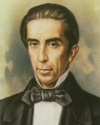
|
Francisco Javier Echeverría (1797–1852) |
September 22, 1841 | October 10, 1841 | He was appointed interim president when Bustamante left office to fight a rebellion headed by Mariano Paredes y Arrillaga, Santa Anna and Gabriel Valencia. He resigned after the triumph of the rebellion.[42][43][44] |

|
Antonio López de Santa Anna (1794–1876) |
October 10, 1841 | October 26, 1842 | He was appointed provisional president by a Junta de Representantes de los Departamentos (Board of Representatives of the Departments).[45][46][47] | |

|
Nicolás Bravo (1786–1854) |
October 26, 1842 | March 4, 1843 | He was appointed substitute president by Santa Anna when he left office.[40][47] | |

|
Antonio López de Santa Anna (1794–1876) |
March 4, 1843 | October 4, 1843 | He reassumed the presidency as provisional president.[48] | |
| 13 | 
|
Valentín Canalizo (1794–1850) |
October 4, 1843 | June 4, 1844 | He was appointed interim president by Santa Anna when he left office.[49][50] |

|
Antonio López de Santa Anna (1794–1876) |
June 4, 1844 | September 12, 1844 | He reassumed the presidency after being elected constitutional president by Congress on January 2, 1844.[51][52] | |
| 14 | 
|
José Joaquín de Herrera (1792–1854) |
September 12, 1844 | September 21, 1844 | He was appointed substitute president by Congress to replace the interim president Valentin Canalizo.[52][53] |

|
Valentín Canalizo (1794–1850) |
September 21, 1844 | December 6, 1844 | He assumed the presidency as interim president.[54] | |

|
José Joaquín de Herrera (1792–1854) |
December 6, 1844 | December 30, 1845 | He was appointed interim, and after, constitutional president by Senate after Canalizo was arrested for try to dissolve the Congress.[53][55][56] | |
| 15 | 
|
Mariano Paredes (1797–1849) |
December 31, 1845 | July 28, 1846 | He assumed office via a coup against De Herrera. On June 12, he was appointed interim president.[57][58] |
| Vice President[58] Nicolás Bravo | |||||

|
Nicolás Bravo (1786–1854) |
July 28, 1846 | August 4, 1846 | He took office when Paredes left the presidency to fight the Americans in the Mexican American War. He was deposed by a federalist rebellion led by Jose Mariano Salas and Valentin Gomez Farias.[59][60][61] | |
| 16 | 
|
José Mariano Salas (1797–1867) |
August 5, 1846 | December 23, 1846 | He assumed office as provisional president after the triumph of the federalist rebellion (Plan de la Ciudadela). He put in force the Constitution of 1824 on August 22.[62][63][64] He served both as last president of the Centralist Republic and first of the Second Federal Republic. |
Second Federal Republic (1846–1863)
| No. |
President | Took office | Left office | Notes | |
|---|---|---|---|---|---|
| 16 | 
|
José Mariano Salas (1797–1867) |
August 6, 1846 | December 23, 1846 | After he restored the federalism, he called elections. Santa Anna won the election and was appointed interim president by Congress and Valentin Gomez Farias as vice president.[62][65] |

|
Valentín Gómez Farías (1781–1858) |
December 23, 1846 | March 21, 1847 | As vice president, he took office in place of Santa Anna, who was fighting the Americans in the Mexican American War.[66] | |

|
Antonio López de Santa Anna (1794–1876) |
March 21, 1847 | April 2, 1847 | He took office as elected interim president.[67] | |
| Vice President Valentín Gómez Farías | |||||
| 17 | 
|
Pedro María de Anaya (1795–1854) |
April 2, 1847 | May 20, 1847 | Santa Anna left office to fight in the Mexican American War. Congress abolished the vice presidency and he was appointed as substitute president.[68][69][70] |

|
Antonio López de Santa Anna (1794–1876) |
May 20, 1847 | September 15, 1847 | He reassumed the presidency when De Anaya left office to fight in the Mexican American War.[71][72] | |
| 18 | 
|
Manuel de la Peña y Peña (1789–1850) |
September 16, 1847 | November 13, 1847 | As president of the Supreme Court, he assumed the presidency after Santa Anna's resignation.[73][74] |

|
Pedro María de Anaya (1795–1854) |
November 13, 1847 | January 8, 1848 | He was appointed interim president by Congress when De la Peña y Peña left office in order to negotiate peace with the United States. | |

|
Manuel de la Peña y Peña (1789–1850) |
January 8, 1848 | June 3, 1848 | He reassumed office as provisional president when De Anaya resigned after refusing to give any land to the United States.[75] During his term, he signed the Treaty of Guadalupe Hidalgo. | |

|
José Joaquín de Herrera (1792–1854) |
June 3, 1848 | January 15, 1851 | He was the second president to finish his term and peacefully turned over the presidency to the winner of the Federal Elections of 1850, General Mariano Arista.[76] | |
| 19 | 
|
Mariano Arista (1802–1855) |
January 15, 1851 | January 5, 1853 | He resigned on January 5, 1853 when Congress refuse to give him extraordinary powers to fight the rebellion of Plan del Hospicio, which its goal was bring to Santa Anna once again to the presidency.[77] |
| 20 | 
|
Juan Bautista Ceballos (1811–1859) |
January 5, 1853 | February 7, 1853 | As president of the Supreme Court, he was proposed by President Arista as his successor and confirmed the same day as interim president by Congress.[78] |
| 21 | 
|
Manuel María Lombardini (1802–1853) |
February 8, 1853 | April 20, 1853 | He was appointed provisional president by Congress when Ceballos resigned because of the rebellion of Plan del Hospicio.[79] |

|
Antonio López de Santa Anna (1794–1876) |
April 20, 1853 | August 9, 1855 | He swore as President but ruled as dictator. He called himself "Su Alteza Serenisima" (Serene Highness).[80][81] From this period, the only lasting thing is the Mexican National Anthem.[82][83] | |
| 22 | 
|
Martín Carrera (1806–1871) |
August 9, 1855 | September 12, 1855 | He was appointed interim president after the triumph of the Plan of Ayutla but he took office until August 15.[83][84] |
| 23 | 
|
Rómulo Díaz de la Vega (1800–1877) |
September 12, 1855 | October 4, 1855 | He served as de facto president after Carrera's resignation.[85][86] |
| 24 | 
|
Juan Álvarez (1790–1867) |
October 4, 1855 | December 11, 1855 | He was appointed interim president by a council integrated with one representative of each state after the triumph of the Revolution of Ayutla.[87][88] |
| 25 | 
|
Ignacio Comonfort (1812–1863) |
December 11, 1855 | December 17, 1857 | He was appointed interim president by Juan Alvarez when he resigned. He assumed as constitutional president on December 1, 1857.[89][90] |
| 26 | 
|
Benito Juárez (1806–1872) |
December 18, 1857 | July 18, 1872 | As president of the Supreme Court, he became interim president after the self-coup of Ignacio Comonfort against the Constitution of 1857. He was arrested and freed by Comonfort. He established a liberal constitutional government on January 18, 1858. The struggle between the Liberal and Conservative forces is known as Reform War.[91] |
Presidents recognized by the Conservatives during the Reform War
| President | Took office | Left office | Notes | |
|---|---|---|---|---|

|
Ignacio Comonfort (1812–1863) |
December 17, 1857 | January 21, 1858 | After the declaration of Plan of Tacubaya, Congress declared that he was not longer president but he was recognized by conservatives as president with absolute powers.[92][93] |

|
Félix María Zuloaga (1813–1898) |
January 11, 1858 | December 24, 1858 | After disown Comonfort, Zuloaga was appointed president by the Conservative Party.[94] |

|
Manuel Robles Pezuela (1817–1862) |
December 24, 1858 | January 23, 1859 | He assumed the conservative presidency with the support of the Plan de Navidad.[95][96] |

|
Félix María Zuloaga (1813–1898) |
January 24, 1859 | February 1, 1859 | He was restored to the presidency by counter-rebellion led by Miguel Miramón.[95][97] |

|
Miguel Miramón (1831–1867) |
February 2, 1859 | August 13, 1860 | He assumed the conservative presidency as substitute when Zuloaga left office.[98] |

|
José Ignacio Pavón (1791–1866) |
August 13, 1860 | August 15, 1860 | As president of the Supreme Court of the conservative government, he took office for two days when Miramón left office.[99] |

|
Miguel Miramón (1831–1867) |
August 15, 1860 | December 24, 1860 | He took office as interim president of the conservative government after he was elected by a group of "Representatives of the States" who supported the conservatives. He was defeated at the Battle of Calpulalpan, resigned the presidency and fled the country.[100] |

|
Félix María Zuloaga (1813–1898) |
May 23, 1860 | December 28, 1862 | Despite having been defeated, the conservatives appointed Zuloaga as president until December 28, when they recognized the Regency who was seeking to reestablish the Mexican Empire.[101] |
Second Mexican Empire (1863–1867)
Regency
On June 22, 1863, was established a "Superior Board Governing". On July 11, the Board became the Regency of the Empire.[102][103]
| Regent[3] | Took office | Left office | Notes | |
|---|---|---|---|---|

|
Juan Nepomuceno Almonte | July 11, 1863 | April 10, 1864 | |

|
José Mariano Salas | July 11, 1863 | April 10, 1864 | |

|
Pelagio Antonio de Labastida | October 19, 1863 | April 10, 1864 | |
Maximilian I
| Emperor | Coat of Arms | Reign Start | Reign Ended | Royal House | Consort | ||
|---|---|---|---|---|---|---|---|

|
Maximilian I (1832–1867) |

|
April 10, 1864 | June 19, 1867 | Habsburg-Lorraine | 
|
Carlota of Mexico (1840–1927) |
Restored Republic (1867–1876)
| No. |
President | Took office | Left office | Notes | |
|---|---|---|---|---|---|

|
Benito Juárez (1806–1872) |
December 18, 1857 | June 11, 1861 | The first term he was interim president during the Reform War. The second term was appointed constitutional president by Congress. The third term was an extension of the second, consequence of the invasion. The fourth and fifth terms were after the triumph of the Republic. | |
| June 11, 1861 | November 30, 1865 | ||||
| December 1, 1865 | December 7, 1867 | ||||
| December 8, 1867 | October 11, 1871 | ||||
| October 12, 1871 | July 18, 1872 | ||||
| 27 | 
|
Sebastián Lerdo de Tejada (1823–1889) |
July 18, 1872 | November 30, 1872 | As president of the Supreme Court, he became interim president after the death of Juarez. He was overthrown by the Revolution of Tuxtepec and left office ten days before the end of his term.[104] |
| December 1, 1872 | November 20, 1876 | ||||
| 28 | 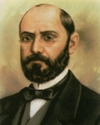
|
José María Iglesias (1823–1891) |
October 26, 1876 | November 28, 1876 | As president of the Supreme Court, he declared himself interim president when Congress declared the reelection of Lerdo de Tejada. When Lerdo de Tejada went to exile on November 20, he became constitutional interim president.[105] |
Porfiriato (1876–1911)
| No. |
President | Took office | Left office | Notes | |
|---|---|---|---|---|---|
| 29 | 
|
Porfirio Díaz (1830–1915) |
November 28, 1876 | December 6, 1876 | He became provisional president when Iglesias went to exile.[106] |
| 30 | 
|
Juan Nepomuceno Méndez (1824–1894) |
December 6, 1876 | February 17, 1877 | He was appointed substitute president by Díaz when he left office to fight the supporters of Lerdo de Tejada.[107] |

|
Porfirio Díaz (1830–1915) |
February 17, 1877 | November 30, 1880 | He reassumed the presidency. On May 2, he was appointed constitutional president by Congress.[108] | |
| 31 | 
|
Manuel González Flores (1833–1893) |
December 1, 1880 | November 30, 1884 | He was the winner of the federal elections of 1880.[109] |

|
Porfirio Díaz (1830–1915) |
December 1, 1884 | November 30, 1888 | He was the winner of the federal elections of 1884, 1888, 1892, 1896, 1900, 1904 and 1910. He resigned during his 7th term after the triumph of the Mexican Revolution.[110] | |
| December 1, 1888 | November 30, 1892 | ||||
| December 1, 1892 | November 30, 1896 | ||||
| December 1, 1896 | November 30, 1900 | ||||
| December 1, 1900 | November 30, 1904 | ||||
| December 1, 1904 | November 30, 1910 | Vice President Ramón Corral (since 1904) | |||
| December 1, 1910 | May 25, 1911 | ||||
Revolution (1910–1920)
| No. | President | Took office | Left office | Notes | |
|---|---|---|---|---|---|
| 32 | 
|
Francisco León de la Barra (1863–1939) |
May 25, 1911 | November 5, 1911 | According the "Treaties of Ciudad Juárez", he assumed as interim president. Immediately called for elections.[111] |
| 33 | 
|
Francisco I. Madero (1873–1913) |
November 6, 1911 | February 19, 1913 | He was the winner of the special election of 1911. He was overthrown by a coup known as Ten Tragic Days in which were involved Victoriano Huerta, Félix Díaz and the American ambassador Henry L. Wilson. He was murdered two days later along with the vice president Pino Suarez.[112][113] |
| Vice President José María Pino Suárez | |||||
| 34 | File:Pedro Lascurain (480x600).jpg | Pedro Lascuráin (1856–1952) |
February 19, 1913 | As Secretary of Foreign Affairs, he assumed as interim president according the constitution. In about 45 minutes, he appointed Victoriano Huerta as Secretary of Interior and then resigned to the Presidency.[114] | |
| 35 | 
|
Victoriano Huerta (1850–1916) |
February 19, 1913 | July 15, 1914 | He assumed office via a coup against Francisco I. Madero. He was defeated by constitutionalist army led by Governor of Coahuila, Venustiano Carranza.[115][116] |
| 36 | 
|
Francisco S. Carvajal (1870–1932) |
July 15, 1914 | August 13, 1914 | He assumed as Interim President after the resignation of Huerta. He resigned after the signing of the Treaties of Teoloyucan.[117] |
| 37 | File:Presidente Venustiano Carrranza (480x600).jpg | Venustiano Carranza (1859–1920) |
Head of the Executive Power First Chief of the Constitutionalist Army |
He served as Head of the Executive Power after the resignation of Carvajal. He convoked a Constitutional Convention which enacted the Political Constitution of the United Mexican States. He won the federal election of 1917 and took office as Constitutional President on May 1, 1917. He was killed during the Rebellion of Agua Prieta.[118] | |
| August 14, 1914 | April 30, 1917 | ||||
| President of Mexico | |||||
| May 1, 1917 | May 21, 1920 | ||||
| 38 | 
|
Adolfo de la Huerta (1881–1955) |
June 1, 1920 | November 30, 1920 | He was appointed provisional president by Congress.[119] |
| 39 | 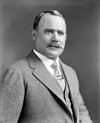
|
Álvaro Obregón (1880–1928) |
December 1, 1920 | November 30, 1924 | He was the winner of the federal elections of 1920.[120] |
| 40 | 
|
Plutarco Elías Calles (1877–1945) |
December 1, 1924 | November 30, 1928 | He was the winner of the federal elections of 1924.[121] |
Presidents recognized by the Convention of Aguascalientes
| President | Took office | Left office | Notes | |
|---|---|---|---|---|

|
Eulalio Gutiérrez (1881–1939) |
November 6, 1914 | January 16, 1915 | He was appointed provisional president by the Convention of Aguascalientes.[122] |

|
Roque González Garza (1885–1962) |
January 16, 1915 | June 10, 1915 | He was appointed provisional president by the Convention of Aguascalientes after Gutierrez left Mexico City.[123] |

|
Francisco Lagos Cházaro (1878–1932) |
June 10, 1915 | October 10, 1915 | He assumed as provisional president when González Garza resigned. He was the last president of the Convention.[124] |
Maximato (1928–1934)
- Party
| No. | President | Took office | Left office | Notes | |
|---|---|---|---|---|---|
| 41 | 
|
Emilio Portes Gil (1890–1978) |
December 1, 1928 | February 4, 1930 | After the assassination of president-elect Alvaro Obregón, he was appointed interim president by Congress.[125] |
| 42 | 
|
Pascual Ortiz Rubio (1877–1963) |
February 5, 1930 | September 4, 1932 | He was the winner of the federal elections of 1929. He resigned from the intervention of Calles in his government.[126][127] |
| 43 | 
|
Abelardo L. Rodríguez (1889–1967) |
September 4, 1932 | November 30, 1934 | He was appointed substitute president by Congress to conclude the term 1930-1934.[128] |
Modern Mexico (Six-Year Term)
After the constitutional reform of 1933, the presidential term in Mexico was extended to six years without the possibility of reelection. After the federal election of 1934 all the presidents have completed their terms.
- Parties
National Revolutionary Party Party of the Mexican Revolution Institutional Revolutionary Party National Action Party
| No. | President | Took office | Left office | Notes | |
|---|---|---|---|---|---|
| 44 | 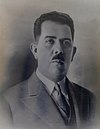
|
Lázaro Cárdenas del Río (1895–1970) |
December 1, 1934 | November 30, 1940 | He was the winner of the federal elections of 1934. |
| 45 | File:Manuel Ávila Camacho, portrait.jpg | Manuel Ávila Camacho (1896–1955) |
December 1, 1940 | November 30, 1946 | He was the winner of the federal elections of 1940. |
| style="background:Template:Institutional Revolutionary Party/meta/color;" | 46 | 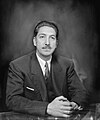
|
Miguel Alemán Valdés (1900–1983) |
December 1, 1946 | November 30, 1952 | He was the winner of the federal elections of 1946. |
| style="background:Template:Institutional Revolutionary Party/meta/color;" | 47 | 
|
Adolfo Ruiz Cortines (1889–1973) |
December 1, 1952 | November 30, 1958 | He was the winner of the federal elections of 1952. |
| style="background:Template:Institutional Revolutionary Party/meta/color;" | 48 | 
|
Adolfo López Mateos (1910–1969) |
December 1, 1958 | November 30, 1964 | He was the winner of the federal elections of 1958. |
| style="background:Template:Institutional Revolutionary Party/meta/color;" | 49 | File:Presidente Diaz Ordaz.jpg | Gustavo Díaz Ordaz (1911–1979) |
December 1, 1964 | November 30, 1970 | He was the winner of the federal elections of 1964. |
| style="background:Template:Institutional Revolutionary Party/meta/color;" | 50 | File:Presidente Echeverria.jpg | Luis Echeverría (1922–) |
December 1, 1970 | November 30, 1976 | He was the winner of the federal elections of 1970. |
| style="background:Template:Institutional Revolutionary Party/meta/color;" | 51 | 
|
José López Portillo (1920–2004) |
December 1, 1976 | November 30, 1982 | He was the winner of the federal elections of 1976. |
| style="background:Template:Institutional Revolutionary Party/meta/color;" | 52 | 
|
Miguel de la Madrid (1934–2012) |
December 1, 1982 | November 30, 1988 | He was the winner of the federal elections of 1982. |
| style="background:Template:Institutional Revolutionary Party/meta/color;" | 53 | 
|
Carlos Salinas de Gortari (1948–) |
December 1, 1988 | November 30, 1994 | He was the winner of the federal elections of 1988. |
| style="background:Template:Institutional Revolutionary Party/meta/color;" | 54 | 
|
Ernesto Zedillo (1951–) |
December 1, 1994 | November 30, 2000 | He was the winner of the federal elections of 1994. |
| style="background:Template:National Action Party (Mexico)/meta/color;" | 55 | 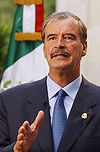
|
Vicente Fox (1942–) |
December 1, 2000 | November 30, 2006 | He was the winner of the federal elections of 2000. |
| style="background:Template:National Action Party (Mexico)/meta/color;" | 56 | 
|
Felipe Calderón (1962–) |
December 1, 2006 | November 30, 2012 | He was the winner of the federal elections of 2006. |
| style="background:Template:Institutional Revolutionary Party/meta/color;" | 57 | 
|
Enrique Peña Nieto (1966–) |
December 1, 2012 | Incumbent | He was the winner of the federal elections of 2012. |
Living former presidents
As of May 2013[update], there are five living former presidents of Mexico. The most recent death of a former president was that of Miguel de la Madrid (1982–1988), on April 1, 2012.
-
Luis Echeverría
(born 1922) served 1970–1976 -
Carlos Salinas de Gortari
(born 1948) served 1988–1994 -
Ernesto Zedillo
(born 1951) served 1994–2000 -
Vicente Fox
(born 1942) served 2000–2006 -
Felipe Calderón
(born 1962) served 2006–2012
Presidents who died in office
| President | Term of office | Date of death | Notes |
|---|---|---|---|
| Miguel Barragán | 1835–1836 | March 1, 1836 (age 46) | He died in National Palace victim of typhus two days after left the presidency to Jose Justo Corro. |
| Benito Juárez | 1857–1872 | July 18, 1872 (age 66) | He is the only President of Mexico who died because of a non-violent cause while in office. |
| Francisco I. Madero | 1911–1913 | February 21, 1913 (age 39) | He was killed three days after he was forced to sign his resignation as result of la Decena Trágica. |
| Venustiano Carranza | 1914–1920 | May 21, 1920 (age 60) | He is the only President of Mexico killed in office. |
| Álvaro Obregón | 1920–1924 | July 17, 1928 (age 48) | He is the only president-elect of Mexico killed before taking office. |
See also
References
- ^ "The Political Constitution of the United Mexican States" (PDF). Instituto de Investigaciones Jurídicas (UNAM). p. 78. Retrieved August 9, 2011.
- ^ Iturriaga, XXXX: 61.
- ^ a b c "El viajero en México: Ó sea la capital de la República, encerrada en un libro". Open Library. Retrieved August 9, 2011.
- ^ INEHRM Secretaría de Gobernación
- ^ "El Viajero en México (Pág. 30)" (PDF). CDigital. Retrieved September 12, 2010.
- ^ "Decreto. Nombramiento de los individuos que han de componer el poder ejecutivo" (in Spanish). 500 años de México en documentos. Retrieved August 8, 2011.
- ^ "Decreto. Nombramiento de suplentes para el supremo poder ejecutivo" (in Spanish). 500 años de México en documentos. Retrieved August 8, 2011.
- ^ "Vicente Guerrero, 1782-1831" (in Spanish). Gobierno Federal. Retrieved August 8, 2011.
- ^ "How the First President of the United Mexican States came into office" (PDF). 500 años de México en documentos. Retrieved October 3, 2010.
- ^ La expulsión de los españoles de México y su destino incierto, 1821-1836 (in Spanish). pp. 74–75. Retrieved October 12, 2010.
- ^ "Vicente Guerrero". Federal Government Of Mexico. Retrieved August 9, 2011.
- ^ "Acuerdo de la Cámara de Diputados. Elección de presidente interino de la República en el Excmo. Sr. D. José María Bocanegra" (in Spanish). Retrieved July 8, 2011.
- ^ "José María Bocanegra asume interinamente la presidencia de la República, por licencia de Vicente Guerrero" (in Spanish). Retrieved August 9, 2011.
- ^ "Acuerdo del consejo de gobierno. Nombramiento de asociados al Excmo. Sr. Presidente de la Suprema Corte de Justicia, para ejercer el supremo poder ejecutivo" (in Spanish). Retrieved August 9, 2011.
- ^ "Anastasio Bustamante, vicepresidente con Vicente Guerrero, asume la Presidencia de la República" (in Spanish). Retrieved August 9, 2011.
- ^ "Melchor Múzquiz sustituye como presidente interino a Anastasio Bustamante" (in Spanish). Retrieved August 9, 2011.
- ^ "Melchor Múzquiz" (in Spanish). Presidencia de la Republica. Retrieved August 9, 2011.
- ^ "Anastasio Bustamante" (in Spanish). Secretaria de Educación Publica en el Distrito Federal. Retrieved August 9, 2011.
- ^ "Manuel Gómez Pedraza" (in Spanish). Retrieved August 9, 2011.
- ^ "Manuel Gómez Pedraza asume la presidencia de la República mediante los convenios de Zavaleta" (in Spanish). Memoria Politica de Mexico. Retrieved August 9, 2011.
- ^ "El Sr. D. Valentín Gómez Farías, al jurar como Vicepresidente" (in Spanish). Memoria Política de México. Retrieved August 9, 2011.
- ^ a b "Santa Anna asume por primera vez la presidencia de México" (in Spanish). Imagen Política de México y del Mundo. Retrieved August 9, 2011.
- ^ a b c "Valentín Gómez Farías" (in Spanish). Presidencia de la Republica. Retrieved August 9, 2011.
- ^ a b "Antonio López de Santa Anna" (in Spanish). Federal Government of Mexico. Retrieved August 9, 2011.
- ^ "Antonio López de Santa Anna asume por primera vez la presidencia de México" (in Spanish). Memoria Política de México. Retrieved August 9, 2011.
- ^ a b c "La adicción al poder. Reelección o No Reelección" (in Spanish). Internet para el profesional de la política. p. 2. Retrieved August 9, 2011.
- ^ a b "Santa Anna asume el poder; Valentín Gómez Farías va al exilio" (in Spanish). Memoria Política de México. Retrieved August 9, 2011.
- ^ "Relación Cronológica de las Legislaturas de la Cámara de Diputados" (PDF) (in Spanish). Cámara de Diputados. Retrieved August 9, 2011.
- ^ a b "Asume la presidencia de la República interinamente el general Miguel Barragán en sustitución de Santa Anna" (in Spanish). Memoria Política de México. Retrieved August 10, 2011.
- ^ Riva Palacio, Vicente (1940). México a través de los siglos (in Spanish). Editorial Cumbre. Retrieved August 10, 2011.
- ^ De La Fuente Guerrero, Sara C. (2003). Las Constituciones de México (in Spanish). México: Servigraf.
- ^ "Bases constitucionales expedidas por el Congreso Constituyente" (in Spanish). Retrieved August 10, 2011.
- ^ "José Justo Corro asume el cargo de presidente interino por la enfermedad del general Miguel Barragán" (in Spanish). Retrieved August 10, 2011.
- ^ "Decreto que expide las Leyes Constitucionales de la República Mexicana". 500 años de México en documentos. Retrieved August 10, 2011.
- ^ "Tratado definitivo de paz y amistad entre México y España" (PDF). 500 años de México en documentos. Retrieved August 10, 2011.
- ^ "La primera República Federal 1824-1835" (PDF) (in Spanish). p. 8. Retrieved August 10, 2011.
- ^ "Anastasio Bustamante". Federal Government of Mexico. Retrieved August 10, 2011.
- ^ "López de Santa Anna y Pérez Lebrón, Antonio" (in Spanish). Retrieved August 10, 2011.
- ^ "Nicolás Bravo 1786-1854" (in Spanish). Retrieved August 10, 2011.
- ^ a b "Nicolás Bravo" (in Spanish). Retrieved August 10, 2011.
- ^ "Anastasio Bustamante". Government of the State of Aguascalientes. Retrieved August 10, 2011.
- ^ "Anastasio Bustamante". Memoria Política de México. Retrieved August 30, 2011.
- ^ "Francisco Javier Echeverría asume la presidencia de la República". Memoria Política de México. Retrieved August 30, 2011.
- ^ "Francisco Javier Echeverría". Presidencia de la Republica. Retrieved August 30, 2011.
- ^ "Decreto de la Junta de Representantes. Se declara Presidente de la República, a D. Antonio López de Santa-Anna". Memoria Política de México. Retrieved August 30, 2011.
- ^ "Junta de Representantes o Consejo de los Departamentos". Instituto de Investigaciones Históricas (UNAM). Retrieved August 30, 2011.
- ^ a b "Efemérides / Santa Anna". Secretaria de Educación Publica del D.F. Retrieved August 30, 2011.
- ^ "Decreto del gobierno. Sobre que volverá a ejercer el poder ejecutivo, luego que llegue a la capital, el general Santa-Anna". Memoria Política de México. Retrieved August 30, 2011.
- ^ "Decreto del gobierno. Se deposita el gobierno provisional de la República en el general D. Valentín Canalizo". Memoria Política de México. Retrieved August 30, 2011.
- ^ "Valentín Canalizo asume la presidencia de la República como sustituto de Santa Anna". Memoria Política de México. Retrieved August 30, 2011.
- ^ "Ley. Se declara presidente constitucional de la República, á D. Antonio López de Santa-Anna". Memoria Política de México. Retrieved August 30, 2011.
- ^ a b "Efemérides / Santa Anna". Secretaria de Educación Publica del D.F. Retrieved August 30, 2011.
- ^ a b "Valentín Canalizo es nombrado presidente interino de la República". Memoria Política de México. Retrieved August 30, 2011.
- ^ "Canalizo, Valentín". Memoria Política de México. Retrieved August 30, 2011.
- ^ "Herrera asume la Presidencia tras un levantamiento popular". Memoria Política de México. Retrieved August 30, 2011.
- ^ "Decreto del senado. Se declara presidente interino de la República, á D. José Joaquín de Herrera". Memoria Política de México. Retrieved August 30, 2011.
- ^ "Mariano Paredes". Presidencia de la Republica. Retrieved August 30, 2011.
- ^ a b "Decreto del congreso extraordinario. Se declarará presidente interino á D. Mariano Paredes y Arrillaga". Memoria Política de México. Retrieved August 30, 2011.
- ^ "Nicolás Bravo asume la presidencia de la República". Memoria Política de México. Retrieved August 30, 2011.
- ^ "Se concede permiso al presidente de la República, para mandar en persona las fuerzas de tierra". Memoria Política de México. Retrieved August 30, 2011.
- ^ "Manifiesto de Mariano Salas y Valentín Gómez Farías". 500 años de México en documentos. Retrieved August 30, 2011.
- ^ a b "El General Mariano Salas toma posesión de la presidencia de la República". Memoria Política de México. Retrieved August 30, 2011.
- ^ "Republica Federal" (PDF). El Viajero en México. p. 5. Retrieved August 30, 2011.
- ^ "Se declara vigente la Constitución de 1824". Memoria Política de México. Retrieved August 30, 2011.
- ^ "Se declara presidente interino de la República, á D. Antonio Lopez de Santa-Anna". Memoria Política de México. Retrieved August 30, 2011.
- ^ "Se declara que D. Valentín Gómez Farías queda en posesion de su encargo de vicepresidente de la República". Memoria Política de México. Retrieved August 30, 2011.
- ^ "21 DE MARZO DE 1847". Biblioteca Digital. Retrieved August 30, 2011.
- ^ "Efemerides/Pedro María Anaya". Secretaria de Educacion Publica del D.F. Retrieved September 3, 2011.
- ^ "Desemejanzas entre el lider politico y el jefe militar" (PDF). Senate of Mexico. p. 2. Retrieved September 3, 2011.
- ^ "Se concede licencia al actual presidente para mandar el ejército, y se suprime la vicepresidencia de la República". Memoria Política de México. Retrieved September 3, 2011.
- ^ "Pedro María de Anaya". Presidencia de la Republica. Retrieved September 3, 2011.
- ^ "Tropas mexicanas al mando de Pedro María Anaya y Manuel Rincón luchan contra las fuerzas al mando de Scott en Churubusco". Memoria Política de México. Retrieved September 3, 2011.
- ^ "El Presidente de la República, a sus compatriotas". Memoria Política de México. Retrieved September 3, 2011.
- ^ "Manuel de la Peña y Peña". Presidencia de la Republica. Retrieved September 3, 2011.
- ^ "El general Pedro María Anaya asume la presidencia de la República". Memoria Política de México. Retrieved October 6, 2011.
- ^ "Herrera, José Joaquín de". Memoria Política de México. Retrieved July 19, 2012.
- ^ "Tras reñidas elecciones, el general Mariano Arista asume pacíficamente la presidencia de la República". Memoria Política de México. Retrieved July 19, 2012.
- ^ "Juan Bautista Ceballos asume el poder ejecutivo tras la renuncia del presidente Mariano Arista". Memoria Política de México. Retrieved July 19, 2012.
- ^ "Lombardini asume la Presidencia". Memoria Política de México. Retrieved July 19, 2012.
- ^ "Santa Anna". Secretaria de Educacion Publica del D.F. Retrieved July 19, 2012.
- ^ "López de Santa Anna y Pérez Lebrón Antonio". Memoria Política de México. Retrieved July 19, 2012.
- ^ "Símbolos patrios de los Estados Unidos Mexicanos". Secretaría de Relaciones Exteriores. Retrieved July 26, 2012.
- ^ a b "Al triunfo del Plan de Ayutla, Santa Anna sale de México". Memoria Política de México. Retrieved July 26, 2012.
- ^ "Martín Carrera". Secretaria de Educacion Publica del Distrito Federal. Retrieved July 26, 2012.
- ^ "Martín Carrera". Gobierno Federal de Mexico. Retrieved August 9, 2012.
- ^ "El general Rómulo Díaz de la Vega asume de facto la presidencia de la República". Memoria Política de México. Retrieved August 9, 2012.
- ^ "Juan Álvarez". Memoria Política de México. Retrieved August 9, 2012.
- ^ "1855 Decreto del gobierno. Se nombra presidente de la República al general D. Juan Alvarez". Memoria Política de México. Retrieved August 9, 2012.
- ^ "Ignacio Comonfort". Gobierno Federal de México. Retrieved August 9, 2012.
- ^ "Ignacio Comonfort asume la Presidencia". Memoria Política de México. Retrieved August 9, 2012.
- ^ "Juárez García Benito Pablo". Memoria Politica de México. Retrieved April 29, 2013.
- ^ "Es proclamado el Plan de Tacubaya, con el que los conservadores pretenden derogar la Constitución de 1857". Memoria Politica de México. Retrieved April 29, 2013.
- ^ "El Congreso declara que dejó de ser Presidente de la República don Ignacio Comonfort desde el 17 de diciembre de 1857". 500 años de México en documentos. Retrieved April 29, 2013.
- ^ "Tras desconocer a Comonfort, Félix María Zuloaga es nombrado presidente por el partido conservador". Memoria Politica de México. Retrieved April 30, 2013.
- ^ a b "Asume la presidencia del gobierno conservador el general Manuel Robles Pezuela". Memoria Politica de México. Retrieved April 30, 2013.
- ^ "Plan de Navidad". Memoria Politica de México. Retrieved April 30, 2013.
- ^ "FÉLIX MARÍA ZULOAGA (1813–1898)". Bicentenario de México. Retrieved April 30, 2013.
- ^ "Zuloaga nombra presidente sustituto de la República a Miguel Miramón". Memoria Politica de México. Retrieved April 30, 2013.
- ^ "José Ignacio Pavón, presidente de la Suprema Corte, se encarga durante dos días del poder ejecutivo del gobierno conservador". Memoria Politica de México. Retrieved April 30, 2013.
- ^ "Toma posesión como presidente interino de la República, Miguel Miramón. Juárez sigue siendo el presidente legal". Memoria Politica de México. Retrieved April 30, 2013.
- ^ "Felix Maria Zuloaga". Chihuahua, México. Retrieved April 30, 2013.
- ^ "Se establece la regencia del Imperio mexicano". 500 años de México. Retrieved April 30, 2013.
- ^ "Acta de la primera reunión de la Junta Superior de Gobierno". 500 años de México. Retrieved April 30, 2013.
- ^ "Lerdo de Tejada Sebastián". Memoria Politica de México. Retrieved May 1, 2013.
- ^ "El Congreso declara la reelección de Lerdo de Tejada y José Ma. Iglesias se da a la rebeldía". Memoria Politica de México. Retrieved May 1, 2013.
- ^ "Porfirio Díaz asume el poder por primera vez". Memoria Politica de México. Retrieved May 1, 2013.
- ^ "El general Juan N. Méndez ocupa la presidencia en tanto Porfirio Díaz termina con los últimos reductos de las fuerzas de Iglesias y de Lerdo de Tejada". Memoria Politica de México. Retrieved May 1, 2013.
- ^ "Porfirio Díaz es nombrado presidente constitucional de la República". Memoria Politica de México. Retrieved May 1, 2013.
- ^ "El general Manuel González toma posesión como presidente constitucional". Memoria Politica de México. Retrieved May 1, 2013.
- ^ "Díaz Mori Porfirio". Memoria Politica de México. Retrieved May 1, 2013.
- ^ "León de la Barra Francisco". Memoria Politica de México. Retrieved May 1, 2013.
- ^ "Francisco I. Madero asume el cargo de la Presidente de la República". Memoria Politica de México. Retrieved May 1, 2013.
- ^ "Se consuma la traición: Huerta y Wilson firman el Pacto de la Embajada". Memoria Politica de México. Retrieved May 1, 2013.
- ^ "Por sólo cuarenta y cinco minutos, Pedro Lascuráin Paredes asume el cargo de presidente interino". Memoria Politica de México. Retrieved May 2, 2013.
- ^ "Victoriano Huerta asume la presidencia y rinde la protesta de ley ante los diputados". Memoria Politica de México. Retrieved May 2, 2013.
- ^ "Victoriano Huerta, vencido por las fuerzas constitucionalistas, renuncia a la Presidencia de la República". Memoria Politica de México. Retrieved May 2, 2013.
- ^ "FRANCISCO S. CARVAJAL". Bicentenario de México. Retrieved May 2, 2013.
- ^ "Carranza Garza Venustiano". Bicentenario de México. Retrieved May 2, 2013.
- ^ "Adolfo de la Huerta asume la presidencia provisional de la República". Bicentenario de México. Retrieved May 2, 2013.
- ^ "Obregón Salido Álvaro". Bicentenario de México. Retrieved May 2, 2013.
- ^ "Elías Calles Campuzano Plutarco". Bicentenario de México. Retrieved May 2, 2013.
- ^ "Eulalio Gutiérrez Ortiz asume la presidencia del gobierno convencionista". Memoria Politica de México. Retrieved May 10, 2013.
- ^ "El presidente provisional, nombrado por la Convención, Eulalio Gutiérrez, huye de México con los fondos de la Tesorería. Lo sucede Roque González Garza". Memoria Politica de México. Retrieved May 10, 2013.
- ^ "Francisco Lagos Cházaro se convierte en el último presidente del gobierno de la Convención". Memoria Politica de México. Retrieved May 10, 2013.
- ^ "Portes Gil Emilio". Memoria Politica de México. Retrieved May 10, 2013.
- ^ "Pascual Ortiz Rubio sufre un atentado y resulta herido durante su toma posesión de la Presidencia de la República". Memoria Politica de México. Retrieved May 10, 2013.
- ^ "Ortíz Rubio renuncia a la Presidencia. Ejerció su mandato en el periodo del "Maximato" llamado así por el poder real ejercido por Calles". Memoria Politica de México. Retrieved May 10, 2013.
- ^ "Rodríguez Abelardo L." Memoria Politica de México. Retrieved May 10, 2013.




